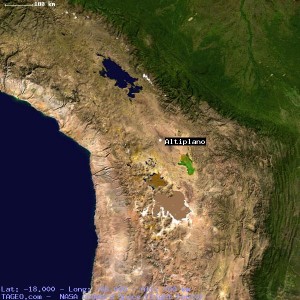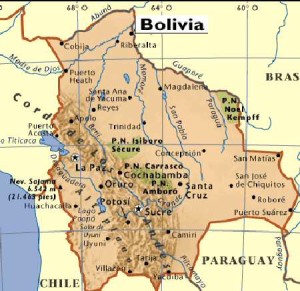Beni
Bolivia *
 The Altiplano of Bolivia has most of its western half situated in the central Andes which includes the Altiplano (High Plateau). Jim Allen, a Scot, has promoted this region[040](a) as the true home of Plato’s Atlantis. Allen claims that ‘Andes’ is a corruption of Antis, a local word that means copper and that the same language uses Atl to denote water. He has identified a site known as Pampa Aullagas as the most likely location of Atlantis. The radical nature of this idea has ensured it widespread attention and sometimes scathing criticism.
The Altiplano of Bolivia has most of its western half situated in the central Andes which includes the Altiplano (High Plateau). Jim Allen, a Scot, has promoted this region[040](a) as the true home of Plato’s Atlantis. Allen claims that ‘Andes’ is a corruption of Antis, a local word that means copper and that the same language uses Atl to denote water. He has identified a site known as Pampa Aullagas as the most likely location of Atlantis. The radical nature of this idea has ensured it widespread attention and sometimes scathing criticism.
Although I cannot subscribe to Jim Allen’s Bolivian location for Atlantis, there is little doubt that Bolivia has yet to reveal all its secrets. For example, there are the little known Sajama lines in western Bolivia near the border with Chile and Peru. These straight Sajama Lines ”average between one and three meters wide, and run from a few meters to several kilometers. The longest of them are about twenty kilometers in length.”(m) Unlike the Nazca lines those at Sajama do not represent any creatures.
Very little research has been carried out on these lines, but I note that Evan Hadingham touched on the subject in Lines to the Mountain Gods[1309] noting that Tony Morrison, who had previously filmed the lines at Nazca[1036], stumbled on those at Sajama, and was told by locals that the lines joined sacred shrines. This was similar to what was told to the noted French anthropologist, Alfred Métraux in the 1930’s.
Returning to the subject of Atlantis, I continue to ask both why or how a mountainous kingdom on the west of South America would attack Athens on the eastern extremity of the Mediterranean is not clear! Allen’s theory concentrates on comparing the topography on the Altiplano with Plato’s description. He compared the physical features described by Plato with the site on the Altiplano and found that there was a very close match except that all the dimensions were out by a factor of two. This he explains by pointing out that unlike the Greeks, the pre-Columbian South Americans used a base 20 for counting. Allen also points to a naturally occurring alloy of copper and gold that is to be found in the Andes as the origin of the Orichalcum mentioned by Plato.
In an effort to strengthen his theory Allen suggests that the bull sacrifice on Atlantis, recorded by Plato, was in fact a reference to llama sacrifices(b)practiced in the Andes for thousands of years right up to the present! He argues that since the Egyptians would have had no word for llama they substituted ‘bull’ for it instead. Although llamas are camelids, I would have thought that they were closer in appearance to goats than bulls. Goat sacrifice is commonplace in the Southern Mediterranean and across much of Asia and has been for millennia. I consider Allen’s suggestion overly speculative and highly improbable.
Atlantisrevealed.com is a website(d), in English and Italian, which supports Jim Allens’s theory of Atlantis on the Altiplano of Bolivia. Unfortunately, it adds little new to the debate. Contrasting that is a lengthy and balanced critique of Allen’s ideas on Timothy Stephany’s website(e). He concludes that there is currently insufficient evidence to justify Allen’s claims.
Advocates of a South American Atlantis have pointed to the discovery of cocaine traces, derived exclusively from the South American coca plant, found in Egyptian mummies as evidence of ancient trans-Atlantic links and a possible channel for the spread of story of the destruction of Atlantis.
David Antelo, a Bolivian engineer, has also proposed a plain, in the Beni region just north of Allen’s site, as the location of Atlantis. In January 2011, Allen’s website included an extensive selection of aerial photos(c) of topographical features in Beni which suggest the pre-existence of an advanced civilisation in the region.
The oldest settlements so far found in Bolivia’s Amazon region are dated at 10,400 years old(f). A recent report(g) has shown numerous large circular earthworks throughout the Bolivian and Brazilian Amazon region. It also reported that the same territory, until recently forest, was savannah as recently as 2,000 or 3,000 thousand years ago.
Near the end of the 19th century, Emeterio Villamil de Rada (1804-1880) created quite a stir when he was the first to suggest that the Garden of Eden had been situated in the Andes and for good measure that the Aymara language was the language of Adam. Comparable ideas were expressed by Ramiro Gonzales Yaksic (1966- ) is the Bolivian author of Earthly Paradise: The Garden of the Andes[1055] in which he claims to have identified the biblical Garden of Eden in his native Bolivia(h). Dieter Groban has written in support of Yaksic(n).
In 2003 Jay Weidner & Vincent Bridges published a book[608] supporting an Andean location for Atlantis(o) in neighbouring Peru. Weidner & Bridges subsequently fell out(i) and Bridges has been accused of organising a scam by Laura Knight-Jadczyk(j).
(a) https://web.archive.org/web/20200811094111/http://www.atlantisbolivia.org/atlantisboliviapart1.htm
(b) https://web.archive.org/web/20190120200652/http://www.atlantisbolivia.org/bullsatlantis.htm
(c) https://web.archive.org/web/20200703083909/http://www.atlantisbolivia.org/beni.htm
(e) See: Archive 2237
(g) https://www.pnas.org/content/early/2014/07/03/1321770111.abstract
(h) See: Archive 2331
(i) https://www.cassiopaea.org/cass/clarification.htm
(j) https://www.cassiopaea.org/cass/vincent-bridges-scam.htm
(l) https://cffbolivia.blogspot.ie/2010/06/ramiro-gonzales-yaksic.html see (h)
(m) https://www.amusingplanet.com/2017/09/the-mysterious-sajama-lines-of-bolivia.html
(n) https://www.facebook.com/Groben.Turismo/posts/926029544094509
(o) Atlantis in the Andes (archive.org) *
Antelo Justiano, David
David Antelo Justiano (1971- ) is a Bolivian engineer who has identified a plain in the Beni region of Bolivia, north-east of La Paz, as that referred to by Plato as being adjacent to Atlantis. Antelo has posted a video on YouTube(a), which offers a comparison of the topography of the region with Plato’s description of Atlantis. It includes a network of pre-Columbian waterways and a  circular feature, which might have been the city. Antelo gives the following co-ordinates for the acropolis, 13° 09′ 35.6” S and 65º 33′ 36 .5” W.
circular feature, which might have been the city. Antelo gives the following co-ordinates for the acropolis, 13° 09′ 35.6” S and 65º 33′ 36 .5” W.
Allan & Delair note that the Beni Basin is also home to features comparable with the Carolina Bays of North America[014.287]. In August 2013 the discovery was announced(d) of middens in the Beni region that were dated to 8000 BC.
Jim Allen, is the leading advocate of Atlantis in the Andes, specifically on the Altiplano to the west of Lake Poopo. Allen refutes Antelo’s claim at the end of a website(b) dealing with Plato’s Plain of Atlantis.
>However, the following excerpt from one of Allen’s essays(f) seems contradictory – “To the NW of the marsh exists the Beni and Mojos territories in Bolivia where recent archaeology reveals another unknown civilisation which dug canals connecting complete river systems and created a system of agriculture using raised plots extending throughout Bolivia into Amazonia.
Marshes are good places for the growing of reeds, excellent for constructing the giant reed ships which may have roamed the world’s oceans and this civilisation which existed on mounds in the Beni region has as yet no name, but as their lands are under water due to flooding for several months of the year, surely there can be no better name than people of Atlantis”<
Antelo published his thesis in 2008 in a book entitled La Conspiración Atlante (The Atlantis Conspiracy).
In 2021, Antelo published Atlantida – Los Paraisos Perdidos: Civilización Hidráulica de los Antis (Atlantis – Paradise Lost: Hydraulic Civilization of the Antis).[1933] A YouTube clip (in Spanish) offers further information(e).
(a) https://www.youtube.com/watch?v=rwAvqvI-ZQU
(b) https://web.archive.org/web/20200707234820/http://www.atlantisbolivia.org/plaincomparison.htm
(c) https://noatlantida.galeon.com/Index.htm (Spanish) (offline October ’14)
(d) https://www.livescience.com/39269-ancient-trash-heaps-reveal-human-settlement.html
(e) ATLANTIS MOXOS – YouTube (Spanish)
(f) http://www.geocities.ws/myessays/LocationofTarshish.htm *
